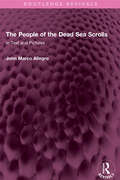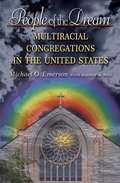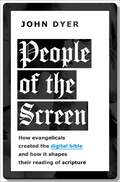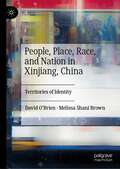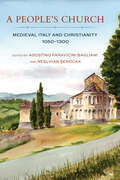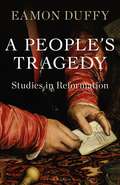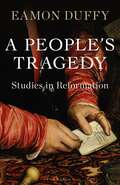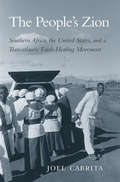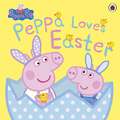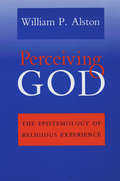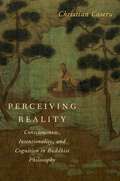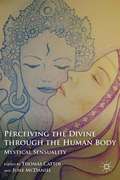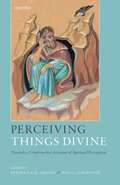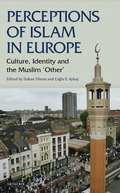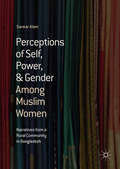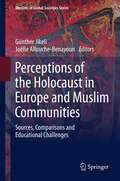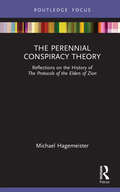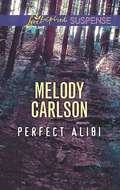- Table View
- List View
The People of the Dead Sea Scrolls: in Text and Pictures (Routledge Revivals)
by John Marco AllegroFirst published in 1959, The People of the Dead Sea Scrolls gives a complete pictorial record of the dramatic story of the Dead Sea Scrolls – actually shows the places where the Scrolls were found, as well as the desert and caves in which the people of the Scrolls lived just before the dawn of Christianity. The striking photographs tell the exciting story of the discovery of the Scrolls and the subsequent archaeological excavations and research. They also show the rocky desert with the remains of the ancient Essene community in which the people of the Scrolls practiced their austere faith, and the Scrolls themselves, which reflect the life of the desert settlement, its leaders, and its religious spirit. This book will be of interest to students of history, religion and archaeology.
People of the Dream: Multiracial Congregations in the United States
by Michael O. EmersonIt is sometimes said that the most segregated time of the week in the United States is Sunday morning. Even as workplaces and public institutions such as the military have become racially integrated, racial separation in Christian religious congregations is the norm. And yet some congregations remain stubbornly, racially mixed. People of the Dream is the most complete study of this phenomenon ever undertaken. Author Michael Emerson explores such questions as: how do racially mixed congregations come together? How are they sustained? Who attends them, how did they get there, and what are their experiences? Engagingly written, the book enters the worlds of these congregations through national surveys and in-depth studies of those attending racially mixed churches. Data for the book was collected over seven years by the author and his research team. It includes more than 2,500 telephone interviews, hundreds of written surveys, and extensive visits to mixed-race congregations throughout the United States. People of the Dream argues that multiracial congregations are bridge organizations that gather and facilitate cross-racial friendships, disproportionately housing people who have substantially more racially diverse social networks than do other Americans. The book concludes that multiracial congregations and the people in them may be harbingers of racial change to come in the United States.
People of the Dream: Multiracial Congregations in the United States
by Michael O. EmersonIt is sometimes said that the most segregated time of the week in the United States is Sunday morning. Even as workplaces and public institutions such as the military have become racially integrated, racial separation in Christian religious congregations is the norm. And yet some congregations remain stubbornly, racially mixed. People of the Dream is the most complete study of this phenomenon ever undertaken. Author Michael Emerson explores such questions as: how do racially mixed congregations come together? How are they sustained? Who attends them, how did they get there, and what are their experiences? Engagingly written, the book enters the worlds of these congregations through national surveys and in-depth studies of those attending racially mixed churches. Data for the book was collected over seven years by the author and his research team. It includes more than 2,500 telephone interviews, hundreds of written surveys, and extensive visits to mixed-race congregations throughout the United States. People of the Dream argues that multiracial congregations are bridge organizations that gather and facilitate cross-racial friendships, disproportionately housing people who have substantially more racially diverse social networks than do other Americans. The book concludes that multiracial congregations and the people in them may be harbingers of racial change to come in the United States.
People of the Screen: How Evangelicals Created the Digital Bible and How It Shapes Their Reading of Scripture
by John DyerPeople of the Screen traces the history of Bible software development, showing the unique and powerful role evangelical entrepreneurs and coders have played in shaping its functionality and how their choices in turn shape the reading habits of millions of people around the world. Examining advancements in Bible software from the first desktop applications to pioneering Bible websites, and later to mobile apps and virtual experiences, this book argues that evangelical creators have a distinct orientation toward societal change and technology called "Hopeful Entrepreneurial Pragmatism" that uniquely positions them to lead the digital Bible market, imbuing their creations with evangelical ways of understanding the nature and purpose of Scripture. This book offers a blend of historical research, interviews with developers, and field work among digital and print Bible readers, offering a nuanced look at the interconnected ecosystem of publishers, developers, pastors, institutions, and software companies. Digital Bibles aren't replacing print Bibles, author John Dyer shows. Rather, the future of Bible engagement involves readers using a mix of print, audio, and screens to suit their needs. He shows that sometimes the God of the page seems to say different things than the God of the screen, suggesting that we are still in the early stages of a multimedia approach to scripture.
People of the Screen: How Evangelicals Created the Digital Bible and How It Shapes Their Reading of Scripture
by John DyerPeople of the Screen traces the history of Bible software development, showing the unique and powerful role evangelical entrepreneurs and coders have played in shaping its functionality and how their choices in turn shape the reading habits of millions of people around the world. Examining advancements in Bible software from the first desktop applications to pioneering Bible websites, and later to mobile apps and virtual experiences, this book argues that evangelical creators have a distinct orientation toward societal change and technology called "Hopeful Entrepreneurial Pragmatism" that uniquely positions them to lead the digital Bible market, imbuing their creations with evangelical ways of understanding the nature and purpose of Scripture. This book offers a blend of historical research, interviews with developers, and field work among digital and print Bible readers, offering a nuanced look at the interconnected ecosystem of publishers, developers, pastors, institutions, and software companies. Digital Bibles aren't replacing print Bibles, author John Dyer shows. Rather, the future of Bible engagement involves readers using a mix of print, audio, and screens to suit their needs. He shows that sometimes the God of the page seems to say different things than the God of the screen, suggesting that we are still in the early stages of a multimedia approach to scripture.
People, Place, Race, and Nation in Xinjiang, China: Territories of Identity
by David O’Brien Melissa Shani BrownIn one of the only works drawing on interviews with both Uyghurs and Han in Xinjiang, China, and postcolonial perspectives on ethnicity, nation, and race, this book explores how forms of banal racism underpin ideas of self and other, assimilation and modernisation, in this restive region. Significant international attention has condemned the CCP’s use of forced internment in ‘re-education’ camps, as well as its campaign of cultural assimilation. In this wider context, this book focuses upon the ways in which ethnic difference is writ through the banalities of everyday life: who one trusts, what one eats, where one shops, even what time one’s clocks are set to (Xinjiang being perhaps one of the only places where different ethnic groups live by different time-zones).Alongside chapters focusing upon the coercive ‘re-education’ campaign, and the devastating Ürümchi Riots in 2009, this book also unpacks how discourses of Chinese nationalism romanticise empire and promote racialised ways of thinking about Chineseness, how cultural assimilation (‘Sinicisation’) is being justified through the rhetoric of ‘modernisation’, how Islamic sites and Uyghur culture are being secularised and commodified for tourist consumption. We also explore Uyghur and Han perspectives, including of each other, giving insight into the diversity of opinions within both groups.Based on many years of living and working in China, and fieldwork and interviews specifically in Xinjiang, this book will be valuable to a variety of readers interested in the region and Uyghur and Han identity, ethnic/national identities in contemporary China, and racisms in non-western contexts.
A People's Church: Medieval Italy and Christianity, 1050–1300
by Agostino Paravicini Bagliani Neslihan ŞenocakA People's Church brings together a distinguished international group of historians to provide a sweeping introduction to Christian religious life and institutions in medieval Italy. Each essay treats a single theme as broadly as possible, highlighting both the unique aspects of medieval Christianity on the Italian peninsula and the beliefs and practices it shared with other Christian societies. Because of its long tradition of communal self-governance, Christianity in medieval Italy, perhaps more than anywhere else, was truly a "people's church." At the same time, its exceptional urban wealth and literacy rates, along with its rich and varied intellectual and artistic culture, led to diverse forms of religious devotion and institutions.Contributors: Maria Pia Alberzoni on heresy; Frances Andrews on urban religion; Cécile Caby on monasticism; Giovanna Casagrande on mendicants; George Dameron on Florence; Antonella Degl'Innocenti on saints; Marina Gazzini on lay confraternities; Maureen C. Miller on bishops; Agostino Paravicini Bagliani and Pietro Silanos on the papacy and Italian politics; Antonio Rigon on clerical confraternities; Neslihan Şenocak on the pievi and care of souls; Giovanni Vitolo on Naples.
A People’s Tragedy: Studies in Reformation
by Eamon DuffyAs an authority on the religion of medieval and early modern England, Eamon Duffy is preeminent. In his revisionist masterpiece The Stripping of the Altars, Duffy opened up new areas of research and entirely fresh perspectives on the origin and progress of the English Reformation.Duffy's focus has always been on the practices and institutions through which ordinary people lived and experienced their religion, but which the Protestant reformers abolished as idolatry and superstition. The first part of A People's Tragedy examines the two most important of these institutions: the rise and fall of pilgrimage to the cathedral shrines of England, and the destruction of the monasteries under Henry VIII, as exemplified by the dissolution of the ancient Anglo-Saxon monastery of Ely. In the title essay of the volume, Duffy tells the harrowing story of the Elizabethan regime's savage suppression of the last Catholic rebellion against the Reformation, the Rising of the Northern Earls in 1569.In the second half of the book Duffy considers the changing ways in which the Reformation has been thought and written about: the evolution of Catholic portrayals of Martin Luther, from hostile caricature to partial approval; the role of historians of the Reformation in the emergence of English national identity; and the improbable story of the twentieth century revival of Anglican and Catholic pilgrimage to the medieval Marian shrine of Walsingham. Finally, he considers the changing ways in which attitudes to the Reformation have been reflected in fiction, culminating with Hilary Mantel's gripping trilogy on the rise and fall of Henry VIII's political and religious fixer, Thomas Cromwell, and her controversial portrayal of Cromwell's Catholic opponent and victim, Sir Thomas More.
A People’s Tragedy: Studies in Reformation
by Eamon DuffyAs an authority on the religion of medieval and early modern England, Eamon Duffy is preeminent. In his revisionist masterpiece The Stripping of the Altars, Duffy opened up new areas of research and entirely fresh perspectives on the origin and progress of the English Reformation.Duffy's focus has always been on the practices and institutions through which ordinary people lived and experienced their religion, but which the Protestant reformers abolished as idolatry and superstition. The first part of A People's Tragedy examines the two most important of these institutions: the rise and fall of pilgrimage to the cathedral shrines of England, and the destruction of the monasteries under Henry VIII, as exemplified by the dissolution of the ancient Anglo-Saxon monastery of Ely. In the title essay of the volume, Duffy tells the harrowing story of the Elizabethan regime's savage suppression of the last Catholic rebellion against the Reformation, the Rising of the Northern Earls in 1569.In the second half of the book Duffy considers the changing ways in which the Reformation has been thought and written about: the evolution of Catholic portrayals of Martin Luther, from hostile caricature to partial approval; the role of historians of the Reformation in the emergence of English national identity; and the improbable story of the twentieth century revival of Anglican and Catholic pilgrimage to the medieval Marian shrine of Walsingham. Finally, he considers the changing ways in which attitudes to the Reformation have been reflected in fiction, culminating with Hilary Mantel's gripping trilogy on the rise and fall of Henry VIII's political and religious fixer, Thomas Cromwell, and her controversial portrayal of Cromwell's Catholic opponent and victim, Sir Thomas More.
The People’s Zion: Southern Africa, the United States, and a Transatlantic Faith-Healing Movement
by Joel CabritaIn The People’s Zion, Joel Cabrita tells the transatlantic story of Southern Africa’s largest popular religious movement, Zionism. It began in Zion City, a utopian community established in 1900 just north of Chicago. The Zionist church, which promoted faith healing, drew tens of thousands of marginalized Americans from across racial and class divides. It also sent missionaries abroad, particularly to Southern Africa, where its uplifting spiritualism and pan-racialism resonated with urban working-class whites and blacks. Circulated throughout Southern Africa by Zion City’s missionaries and literature, Zionism thrived among white and black workers drawn to Johannesburg by the discovery of gold. As in Chicago, these early devotees of faith healing hoped for a color-blind society in which they could acquire equal status and purpose amid demoralizing social and economic circumstances. Defying segregation and later apartheid, black and white Zionists formed a uniquely cosmopolitan community that played a key role in remaking the racial politics of modern Southern Africa. Connecting cities, regions, and societies usually considered in isolation, Cabrita shows how Zionists on either side of the Atlantic used the democratic resources of evangelical Christianity to stake out a place of belonging within rapidly-changing societies. In doing so, they laid claim to nothing less than the Kingdom of God. Today, the number of American Zionists is small, but thousands of independent Zionist churches counting millions of members still dot the Southern African landscape.
The People’s Zion: Southern Africa, the United States, and a Transatlantic Faith-Healing Movement
by Joel CabritaIn The People’s Zion, Joel Cabrita tells the transatlantic story of Southern Africa’s largest popular religious movement, Zionism. It began in Zion City, a utopian community established in 1900 just north of Chicago. The Zionist church, which promoted faith healing, drew tens of thousands of marginalized Americans from across racial and class divides. It also sent missionaries abroad, particularly to Southern Africa, where its uplifting spiritualism and pan-racialism resonated with urban working-class whites and blacks. Circulated throughout Southern Africa by Zion City’s missionaries and literature, Zionism thrived among white and black workers drawn to Johannesburg by the discovery of gold. As in Chicago, these early devotees of faith healing hoped for a color-blind society in which they could acquire equal status and purpose amid demoralizing social and economic circumstances. Defying segregation and later apartheid, black and white Zionists formed a uniquely cosmopolitan community that played a key role in remaking the racial politics of modern Southern Africa. Connecting cities, regions, and societies usually considered in isolation, Cabrita shows how Zionists on either side of the Atlantic used the democratic resources of evangelical Christianity to stake out a place of belonging within rapidly-changing societies. In doing so, they laid claim to nothing less than the Kingdom of God. Today, the number of American Zionists is small, but thousands of independent Zionist churches counting millions of members still dot the Southern African landscape.
Peppa Pig: Peppa Loves Easter (Peppa Pig)
by Peppa PigThis new picture book is the perfect gift this Easter.It's Easter time and Madame Gazelle has a special Easter surprise for Peppa and her friends after playgroup - Miss Rabbit has organised an Easter Egg-stravaganza! There's Easter cakes, Easter cards to make, an egg decorating stall and Granny and Grandpa Pig's fluffy newly-hatched chicks, but where is Miss Rabbit? And who is inside the huge Easter egg?Peppa Loves Easter!Also look out for Peppa Pig: Peppa's Egg-cellent Easter Sticker Activity Book 9780241381014 and Peppa Pig: Peppa the Easter Bunny 9780241411827.
Perceiving God: The Epistemology of Religious Experience
by William P. AlstonIn this clear and provocative account of the epistemology of religious experience, William P. Alston argues that the perception of God—his term for direct experiential awareness of God—makes a major contribution to the grounds of religious belief. Surveying the variety of reported direct experiences of God, Alston demonstrates that a person can be justified in holding certain beliefs about God on the basis of mystical experience.
Perceiving Reality: Consciousness, Intentionality, and Cognition in Buddhist Philosophy
by Christian CoseruWhat turns the continuous flow of experience into perceptually distinct objects? Can our verbal descriptions unambiguously capture what it is like to see, hear, or feel? How might we reason about the testimony that perception alone discloses? Christian Coseru proposes a rigorous and highly original way to answer these questions by developing a framework for understanding perception as a mode of apprehension that is intentionally constituted, pragmatically oriented, and causally effective. By engaging with recent discussions in phenomenology and analytic philosophy of mind, but also by drawing on the work of Husserl and Merleau-Ponty, Coseru offers a sustained argument that Buddhist philosophers, in particular those who follow the tradition of inquiry initiated by Dign?ga and Dharmak?rti, have much to offer when it comes to explaining why epistemological disputes about the evidential role of perceptual experience cannot satisfactorily be resolved without taking into account the structure of our cognitive awareness. Perceiving Reality examines the function of perception and its relation to attention, language, and discursive thought, and provides new ways of conceptualizing the Buddhist defense of the reflexivity thesis of consciousness-namely, that each cognitive event is to be understood as involving a pre-reflective implicit awareness of its own occurrence. Coseru advances an innovative approach to Buddhist philosophy of mind in the form of phenomenological naturalism, and moves beyond comparative approaches to philosophy by emphasizing the continuity of concerns between Buddhist and Western philosophical accounts of the nature of perceptual content and the character of perceptual consciousness.
Perceiving Reality Consciousness C: Consciousness, Intentionality, And Cognition In Buddhist Philosophy
by Christian CoseruPerceiving the Divine through the Human Body: Mystical Sensuality
by T. Cattoi J. McDanielCattoi and McDaniel present a selection of articles on the role of the body and the spiritual senses - our transfigured channels of sensory perceptions - in the context of spiritual practice. The volume investigates this theme across a variety of different religious traditions within Christianity, Hinduism, Buddhism, and Daoism.
Perceiving Things Divine: Towards a Constructive Account of Spiritual Perception
by Paul L. Gavrilyuk Frederick D. AquinoSensory language is commonly used to describe human encounters with the divine. Scripture, for example, employs perceptual language like 'taste and see that the Lord is good', 'hear the word of the Lord', and promises that 'the pure in heart will see God'. Such statements seem to point to certain features of human cognition that make perception-like contact with divine things possible. But how precisely should these statements be construed? Can the elusive notion of 'spiritual perception' survive rigorous theological and philosophical scrutiny and receive a constructive articulation? Perceiving Things Divine seeks to make philosophical and theological sense of spiritual perception. Reflecting the results of the second phase of the Spiritual Perception Project, this volume argues for the possibility of spiritual perception. It also seeks to make progress towards a constructive account of the different aspects of spiritual perception while exploring its intersection with various theological and philosophical themes, such as biblical interpretation, aesthetics, liturgy, race, ecology, eschatology, and the hiddenness of God. The interdisciplinary scope of the volume draws on the resources of value theory, philosophy of perception, epistemology, philosophy of art, psychology, systematic theology, and theological aesthetics. The volume also draws attention to how spiritual perception may be affected by such distortions as pornographic sensibility and racial prejudice. Since perceiving spiritually involves the whole person, the volume proposes that spiritual perception could be purified by ascetic discipline, healed by contemplative practices, trained in the process of spiritual direction and the pursuit of virtue, transformed by the immersion in the sacramental life, and healed by opening the self to the operation of divine grace.
Perceiving Things Divine: Towards a Constructive Account of Spiritual Perception
Sensory language is commonly used to describe human encounters with the divine. Scripture, for example, employs perceptual language like 'taste and see that the Lord is good', 'hear the word of the Lord', and promises that 'the pure in heart will see God'. Such statements seem to point to certain features of human cognition that make perception-like contact with divine things possible. But how precisely should these statements be construed? Can the elusive notion of 'spiritual perception' survive rigorous theological and philosophical scrutiny and receive a constructive articulation? Perceiving Things Divine seeks to make philosophical and theological sense of spiritual perception. Reflecting the results of the second phase of the Spiritual Perception Project, this volume argues for the possibility of spiritual perception. It also seeks to make progress towards a constructive account of the different aspects of spiritual perception while exploring its intersection with various theological and philosophical themes, such as biblical interpretation, aesthetics, liturgy, race, ecology, eschatology, and the hiddenness of God. The interdisciplinary scope of the volume draws on the resources of value theory, philosophy of perception, epistemology, philosophy of art, psychology, systematic theology, and theological aesthetics. The volume also draws attention to how spiritual perception may be affected by such distortions as pornographic sensibility and racial prejudice. Since perceiving spiritually involves the whole person, the volume proposes that spiritual perception could be purified by ascetic discipline, healed by contemplative practices, trained in the process of spiritual direction and the pursuit of virtue, transformed by the immersion in the sacramental life, and healed by opening the self to the operation of divine grace.
Perceptions of Islam in Europe: Culture, Identity and the Muslim 'Other' (Library of Modern Religion)
by Hakan Yilmaz Cagla E. AykacFor centuries, the Islamic world has been represented as the 'other' within European identity constructions - an 'other' perceived to be increasingly at odds with European forms of modernity and culture. With the perceived gap between Islam and Europe widening, leading scholars in this work come together to provide genuine and realistic analyses about perceptions of Islam in the West. The book bridges these analyses with in-depth case studies from Britain, France, Germany, Greece, Italy, the Netherlands, Poland, Turkey and other parts of the European Union. This study goes beyond the usual dichotomies of 'clashes of civilizations' and 'cultural conflict' to try to understand the numerous, diverse and multifaceted ways - some conflictual, some peaceful - in which cultural exchanges have taken place historically, and which continue to take place, between the Muslim and non-Muslim worlds.
Perceptions of Self, Power, & Gender Among Muslim Women: Narratives From A Rural Community In Bangladesh
by Sarwar AlamThis book analyzes perceptions of self, power, agency, and gender of Muslim women in a rural community of Bangladesh. Rural women’s limited power and agency has been subsumed within the male dominated Islamic discourses on gender. However, many Muslim women have their own alternative discourses surrounding power and agency. Sarwar Alam intertwines an exploration of these power dynamics with reading of the Qur’an and Hadith, and analyzes how Muslim women’s perception of power and gender are linked to their relationship with religion.
Perceptions of Self, Power, & Gender Among Muslim Women: Narratives from a Rural Community in Bangladesh
by Sarwar AlamThis book analyzes perceptions of self, power, agency, and gender of Muslim women in a rural community of Bangladesh. Rural women’s limited power and agency has been subsumed within the male dominated Islamic discourses on gender. However, many Muslim women have their own alternative discourses surrounding power and agency. Sarwar Alam intertwines an exploration of these power dynamics with reading of the Qur’an and Hadith, and analyzes how Muslim women’s perception of power and gender are linked to their relationship with religion.
Perceptions of the Holocaust in Europe and Muslim Communities: Sources, Comparisons and Educational Challenges (Muslims in Global Societies Series #5)
by Günther Jikeli and Joëlle Allouche-BenayounThe way people think about the Holocaust is changing. The particular nature of the transformation depends on people’s historical perspectives and how they position themselves and their nation or community vis-à-vis the tragedy. Understandably, European Muslims perceive the Holocaust as less central to their history than do other Europeans. Yet while the acknowledgement and commemoration of the horrors of the Holocaust are increasingly important in Europe, Holocaust denial and biased views on the Holocaust are widespread in European Muslims’ countries of origin.In this book, a number of distinguished scholars and educators of various backgrounds discuss views of the Holocaust. Problematic views are often influenced by a persistent attitude of Holocaust denial which is derived, in part, from discourses in the Muslim communities in their countries of origin. The essays collected here explore the backgrounds of these perceptions and highlight positive approaches and developments. Many of the contributions were written by people working in the field and reflecting on their experiences. This collection also reveals that problematic views of the Holocaust are not limited to Muslim communities.
The Perennial Conspiracy Theory: Reflections on the History of the Protocols of the Elders of Zion (Routledge Studies in Fascism and the Far Right)
by Michael HagemeisterThe Perennial Conspiracy Theory is a collection of essays on The Protocols of the Elders of Zion, a fake document which has created a pernicious antisemitic conspiracy theory. The author analyses the murky origins of this notorious forgery and the contested claims of authorship. He explores the impact of the Protocols on various countries during the interwar years including Soviet Russia, the United Kingdom, France, Nazi Germany, and the United States. He also profiles figures closely associated with the dissemination of antisemitic conspiracy theories, such as Sergei Nilus and Leslie Fry, as well as examining the controversies arising from the famous Bern trial related to the Protocols. The book concludes with an assessment of the ongoing influence of the Protocols in post-Soviet Russia. This volume will be of interest to researchers and students working in the fields of antisemitism, conspiracy theories, the far right, Jewish studies, and modern history.
The Perennial Conspiracy Theory: Reflections on the History of the Protocols of the Elders of Zion (Routledge Studies in Fascism and the Far Right)
by Michael HagemeisterThe Perennial Conspiracy Theory is a collection of essays on The Protocols of the Elders of Zion, a fake document which has created a pernicious antisemitic conspiracy theory. The author analyses the murky origins of this notorious forgery and the contested claims of authorship. He explores the impact of the Protocols on various countries during the interwar years including Soviet Russia, the United Kingdom, France, Nazi Germany, and the United States. He also profiles figures closely associated with the dissemination of antisemitic conspiracy theories, such as Sergei Nilus and Leslie Fry, as well as examining the controversies arising from the famous Bern trial related to the Protocols. The book concludes with an assessment of the ongoing influence of the Protocols in post-Soviet Russia. This volume will be of interest to researchers and students working in the fields of antisemitism, conspiracy theories, the far right, Jewish studies, and modern history.
